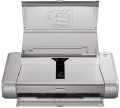Product type
—
Portable. This category includes printers of small size and weight, equipped with their own autonomous power sources. All this makes it easy to transport the device with you and use it even in the absence of sockets. Often, these models are equipped with a Bluetooth module (see "Data Transfer") for easy connection to a laptop or even a smartphone. On the other hand, the functionality of portable printers is noticeably more modest (for example, the format usually does not exceed 10x15), and the price is higher than that of stationary ones. Therefore, you should specifically look for such a model only if mobility is important to you.
Number of colors
The color palette that the printer can print.
A large number of colors is required for high-quality photo printing and obtaining color prints with many shades. The standard is
4 colors.
Max. resolution
The maximum resolution of the image to be printed. It is usually indicated by two numbers denoting the number of dpi (DPI) horizontally and vertical:
600x600, 1200x600,
1200x1200,
2400x600,
2400x1200,
4800x600,
4800x1200,
4800x2400,
5760x1440,
9600x600,
9600x2400. The detail of the image depends on this parameter - the higher the resolution, the more fine details the printer is able to convey and the better their image will be. High print resolution is important, first of all, when working with graphic material; low resolution is sufficient for high-quality text display. So
First page print time
The time from the receipt of a print command to the exit from the printer of the first page printed in black and white, in other words, how long after pressing the "Print" button, the user will receive the first page. Most often indicated for draft (fastest) print mode, higher quality will take longer. You should pay attention to this parameter if you often need to print small documents (on one or several pages) on the printer.
Colour print
Colour print speed provided by the printer. Usually, the specifications give speed at low quality, when performance is highest; on standard and especially high settings, the print speed can be noticeably lower, so it’s worth choosing with a certain margin. It is also worth considering that high speed significantly affects the price, power consumption and noise level. Therefore, it does not always make sense to chase maximum performance — for simple applications and small print volumes, a relatively slow and inexpensive device may be the best choice.
The "slowest" colour printers today are capable of delivering
less than 10 pages per minute. A more decent value is considered
10 – 20 ppm, a speed
of more than 20 ppm can already be called quite good, and in the fastest models this figure
exceeds 30 ppm.
Photo print
Printer print speed in photographic (highest) quality. Unlike other similar parameters, in this case the speed is usually indicated for a 10x15 sheet (A6, the most popular format for photographs). In addition, photo printing speed is not expressed in pages per minute, but in seconds per page, because. printing takes a lot of time. This option is worth paying attention to if you plan to
print photos frequently.
Mono cartridge resource
The maximum number of pages that the printer's ink (toner) can print. The value is rather conditional, in reality the deviations from the norm are very large (up or down). In inkjet printers, the cartridge life is relatively small and amounts to several hundred prints. In laser and LED devices, the bill is already in the thousands.
Colour cartridge resource
The maximum number of pages that the printer's ink (toner) can print. The value is rather conditional, in reality the deviations from the norm are very large (up or down). In inkjet printers, the cartridge life is relatively small and amounts to several hundred prints. In laser and LED devices, the bill is already in the thousands.
Ink type
— Pigment. Ink based on pigments — solid dyes, which are diluted in the form of microparticles in a liquid filler to a state of suspension. Compared to more popular water-based inks, these formulations are noticeably more expensive, and the finished image may turn out to be somewhat less bright (compared to printing with water-based dye on the same printer). On the other hand, pigment ink gives higher detail, which is especially important for photo printing. In addition, finished images resist moisture better and do not fade as quickly in bright light — this resistance is not enough for outdoor use, but indoors such prints can be stored for a very long time.
- Water soluble. Inks based on water-soluble dyes allow achieving high realism of color reproduction in color printing, they are well absorbed into the deep layers of paper and are cheaper than pigment ink. Also, water-soluble ink does not dry as quickly in the cartridge or print head of the printer. They are recommended for use with inkjet paper - ordinary thin paper strongly absorbs dropsy, which can cause ink to show through on the back of the sheet. At the same time, water-soluble inks are afraid of moisture and direct exposure to ultraviolet rays - when water gets in, the paint “floats” on paper, and it fades under sunlight.
– Pigmented / water soluble. Some printers have a print head that allows you to print with two types of ink at once. A common case is when their black cartridge is filled wi...th pigment ink, and the color one is filled with water-soluble ink.
